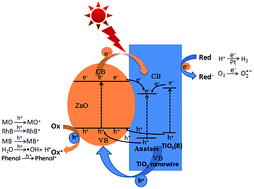Designed synthesis of anatase–TiO2 (B) biphase nanowire/ZnO nanoparticle heterojunction for enhanced photocatalysis†
Abstract
A high performance photocatalyst based on a heterostructure using ZnO nanoparticles (NPs) decorating mesoporous anatase–TiO2 (B) biphase TiO2 nanowires (NWs) was synthesized by a facile water bath reflux method. The morphology, structure, and optical properties of the prepared hybrid photocatalyst were well characterized. The results showed that the mesoporous biphase TiO2 NWs consisted of TiO2 (B) and anatase phases. When ZnO NPs were loaded on the surface of biphase TiO2 NWs, a heterojunction was formed between TiO2 NWs and ZnO NPs that could favor the separation of photogenerated electron–hole pairs. The TiO2–ZnO heterojunction exhibited remarkably enhanced photocatalytic activity and excellent stability for both dye degradation and H2 evolution compared with TiO2 NWs. The heterojunction with a 20 wt% ZnO content exhibited the highest photocatalytic activity and the reaction rate constant was about 4.2 and 1.3 times higher than that of TiO2 NWs for dye degradation and H2 evolution, respectively. The main active species were found to be O2˙− and ˙OH by the electron paramagnetic resonance technique. This work may open a promising avenue in producing highly efficient heterojunction photocatalysts with special structures for large-scale environmental and energy applications.



 Please wait while we load your content...
Please wait while we load your content...